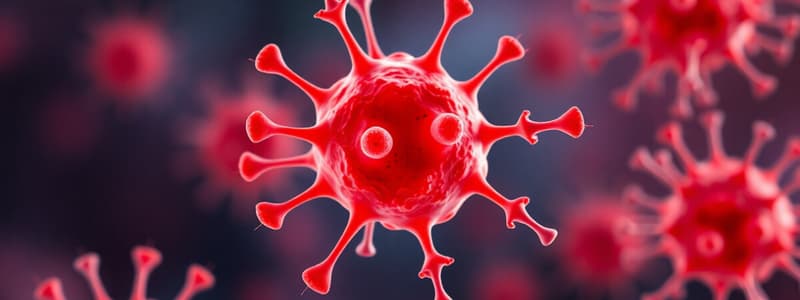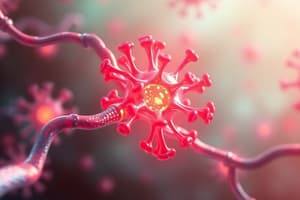Podcast
Questions and Answers
Which non-sedating drug can be used for allergic rhinitis and urticaria?
Which non-sedating drug can be used for allergic rhinitis and urticaria?
- Doxylamine
- Fexofenadine (correct)
- Promethazine
- Atropine
What is the primary indication for pitolisant?
What is the primary indication for pitolisant?
- Treatment of excessive daytime sleepiness in narcolepsy (correct)
- Treatment of allergic rhinitis
- Prevention of motion sickness
- Emergency treatment of anaphylaxis
Which of the following drugs is associated with sedation as an adverse effect?
Which of the following drugs is associated with sedation as an adverse effect?
- Fexofenadine
- Cetirizine (correct)
- Pitolisant
- Azelastine
Which formulation of antihistamine is useful for treating severe drug hypersensitivity reactions?
Which formulation of antihistamine is useful for treating severe drug hypersensitivity reactions?
What can increase the risk of cardiac toxicity and arrhythmia when using second-generation antihistamines?
What can increase the risk of cardiac toxicity and arrhythmia when using second-generation antihistamines?
Which of the following correctly describes an adverse effect associated with 1st and 2nd generation antihistamines?
Which of the following correctly describes an adverse effect associated with 1st and 2nd generation antihistamines?
How do H3 receptor antagonists like pitolisant work in the treatment of narcolepsy?
How do H3 receptor antagonists like pitolisant work in the treatment of narcolepsy?
What type of reaction should be avoided in allergic asthma regarding antihistamines?
What type of reaction should be avoided in allergic asthma regarding antihistamines?
What differentiates inverse agonists from standard antagonists regarding H1 receptors?
What differentiates inverse agonists from standard antagonists regarding H1 receptors?
Which of the following drugs is classified as a first-generation antihistamine?
Which of the following drugs is classified as a first-generation antihistamine?
What is a common side effect of first-generation antihistamines due to their anticholinergic properties?
What is a common side effect of first-generation antihistamines due to their anticholinergic properties?
Which antihistamine generation primarily is used to avoid sedation?
Which antihistamine generation primarily is used to avoid sedation?
What enzyme is primarily responsible for the metabolism of many antihistamines in the liver?
What enzyme is primarily responsible for the metabolism of many antihistamines in the liver?
What is the primary manifestation of an overdose of first-generation antihistamines?
What is the primary manifestation of an overdose of first-generation antihistamines?
What is the expected duration of action for many antihistamines?
What is the expected duration of action for many antihistamines?
Which of the following is NOT a commonly recognized first-generation antihistamine?
Which of the following is NOT a commonly recognized first-generation antihistamine?
Which histamine receptor is primarily responsible for stimulating gastric acid secretion?
Which histamine receptor is primarily responsible for stimulating gastric acid secretion?
What effect does histamine have when acting on the H1 receptor?
What effect does histamine have when acting on the H1 receptor?
Which physiological action of histamine involves promoting wakefulness?
Which physiological action of histamine involves promoting wakefulness?
In the case of allergic reactions, which receptor antagonists are commonly used to control itching?
In the case of allergic reactions, which receptor antagonists are commonly used to control itching?
What is the primary consequence of histamine released during an inflammatory response?
What is the primary consequence of histamine released during an inflammatory response?
Which physiological reaction does histamine induce when injected intradermally?
Which physiological reaction does histamine induce when injected intradermally?
Which type of histamine receptor is linked to the modulation of both innate and acquired immune responses?
Which type of histamine receptor is linked to the modulation of both innate and acquired immune responses?
Which mechanism is responsible for the synthesis of histamine?
Which mechanism is responsible for the synthesis of histamine?
Flashcards
What is histamine?
What is histamine?
Histamine is a chemical messenger found in many tissues, particularly those exposed to the environment like the lungs, skin and gut. It plays a key role in allergic and inflammatory reactions, triggering several effects in the body.
How is histamine released?
How is histamine released?
Histamine is released from mast cells, a type of immune cell, when the body encounters allergens or inflammatory stimuli.
What are histamine receptors?
What are histamine receptors?
Histamine receptors are proteins on the surface of cells that bind to histamine, initiating a series of reactions. There are four types: H1, H2, H3 and H4, each with distinct functions.
What are the effects of the H1 receptor?
What are the effects of the H1 receptor?
Signup and view all the flashcards
What are the effects of the H2 receptor?
What are the effects of the H2 receptor?
Signup and view all the flashcards
What are the effects of the H3 receptor?
What are the effects of the H3 receptor?
Signup and view all the flashcards
What are the effects of the H4 receptor?
What are the effects of the H4 receptor?
Signup and view all the flashcards
What are type I hypersensitivity reactions?
What are type I hypersensitivity reactions?
Signup and view all the flashcards
Antihistamines: What are they?
Antihistamines: What are they?
Signup and view all the flashcards
First-Generation Antihistamines: Side Effect
First-Generation Antihistamines: Side Effect
Signup and view all the flashcards
H1-receptor Antagonist: How it Works
H1-receptor Antagonist: How it Works
Signup and view all the flashcards
H1-receptor Inverse Agonist: How it Works
H1-receptor Inverse Agonist: How it Works
Signup and view all the flashcards
Second-Generation Antihistamines: Advantage
Second-Generation Antihistamines: Advantage
Signup and view all the flashcards
First-Generation Antihistamines: Additional Effects
First-Generation Antihistamines: Additional Effects
Signup and view all the flashcards
Anticholinergic Syndrome: Overdose Effect
Anticholinergic Syndrome: Overdose Effect
Signup and view all the flashcards
Overdose Countermeasure
Overdose Countermeasure
Signup and view all the flashcards
How are second-generation antihistamines clinically used?
How are second-generation antihistamines clinically used?
Signup and view all the flashcards
What is azelastine used for?
What is azelastine used for?
Signup and view all the flashcards
What are antihistamines used for beyond allergies?
What are antihistamines used for beyond allergies?
Signup and view all the flashcards
What is pitolisant and how does it work?
What is pitolisant and how does it work?
Signup and view all the flashcards
How are antihistamines processed in the body and what are their unwanted effects?
How are antihistamines processed in the body and what are their unwanted effects?
Signup and view all the flashcards
What are some contraindications for first and second-generation antihistamines?
What are some contraindications for first and second-generation antihistamines?
Signup and view all the flashcards
What are specific contraindications for second-generation antihistamines?
What are specific contraindications for second-generation antihistamines?
Signup and view all the flashcards
What are the common adverse effects of antihistamines?
What are the common adverse effects of antihistamines?
Signup and view all the flashcards
Study Notes
Lesson 29: Pharmacology of Histamine
- Histamine is a basic amine found in most tissues, but highly concentrated in tissues exposed to the environment (lungs, skin, gastrointestinal tract)
- Histamine released from mast cells during inflammatory or allergic reactions
- Histamine metabolized by histaminase and/or a methylating enzyme
- Histamine synthesis: L-histidine → histamine (via L-histidine decarboxylase)
Histamine Receptors
- Four types of histamine receptors (H1-H4) are G protein-coupled receptors (GPCRs)
- H1 receptor implicated in inflammatory response; associated with [Ca2+]
- H2 receptor implicated in inflammatory response and associated with [AMPc] increase in parietal cells, involved in acid secretion
- The four receptor types are implicated in inflammatory responses
Physiological Actions of Histamine (Summary of Effects)
-
Mediated through H1 receptor:
- Contraction of most smooth muscles (except blood vessels)
- Vasodilation
- Bronchoconstriction
- Increased vascular permeability
- Stimulation of sensory nerve fibers (itching, etc.)
- Influences waking or sleep (H1/H3 involved)
-
Mediated through H2 receptor:
- Stimulation of gastric secretion
- Cardiac stimulation
- Implicated in the pathogenesis of peptic ulcers, stimulating gastric acid secretion
-
Effects on Skin (H1 receptor):
- Injected intradermally, histamine causes the "triple response": Reddening, weal, and flare
- H1 antagonists used to control itching caused by allergic reactions and insect bites
-
Sleep/Wake Homeostasis (H3 receptor):
- H3 receptor antagonists can be used to treat narcolepsy
Antihistamines
-
H1 receptor antagonists and H1 inverse agonists (2nd generation) used to treat inflammatory and allergic conditions
-
Antagonists simply block the H1 receptor, preventing histamine binding
-
Inverse agonists block histamine binding and reduce basal H1 receptor activity, leading to a more potent antiallergic effect
-
Classified as:
- First generation: cross blood-brain barrier, can cause sedation (chlorphenamine, diphenhydramine, etc.)
- Second generation: unlikely to cause sedation (cetirizine, fexofenadine, etc.)
-
Duration of action ranges from 6 to 24 hours (differing by type), facilitating once daily use
Clinical Uses
-
Allergic reactions: non-sedating second-generation antihistamines (fexofenadine, cetirizine) for rhinitis and urticaria. Topical preparations used for allergic conjunctivitis/insect bites. Injectable antihistamines and adrenaline used for severe reactions. Azelastine for nasal allergic symptoms.
-
Antiemetics: Prevention of motion sickness (promethazine, doxylamine) and other causes of nausea
-
Narcolepsy treatment: Pitolisant (H3 receptor antagonist/inverse agonist) for excessive daytime sleepiness
Adverse Effects
-
Mostly metabolized in the liver, excreted in the urine
-
Sedative CNS effects are unwanted when treating allergies
-
Contraindications (1st and 2nd generation):
-
Alcohol
-
Anticholinergics
-
Digestive obstruction
-
Glaucoma
-
Contraindications (2nd generation):
-
Arrhythmias
-
CYP3A4 inhibitors (drug interaction)
-
Adverse Drug Reactions (ADRs):
-
Sedation: dry mouth, blurred vision, constipation, and retention of urine; digestive disturbances
-
Second-generation Drugs: cardiac toxicity/arrhythmia, increased risk when taken with grapefruit juice or agents that inhibit cytochrome P450 in the liver
-
Drug-induced photosensitivity
Studying That Suits You
Use AI to generate personalized quizzes and flashcards to suit your learning preferences.




